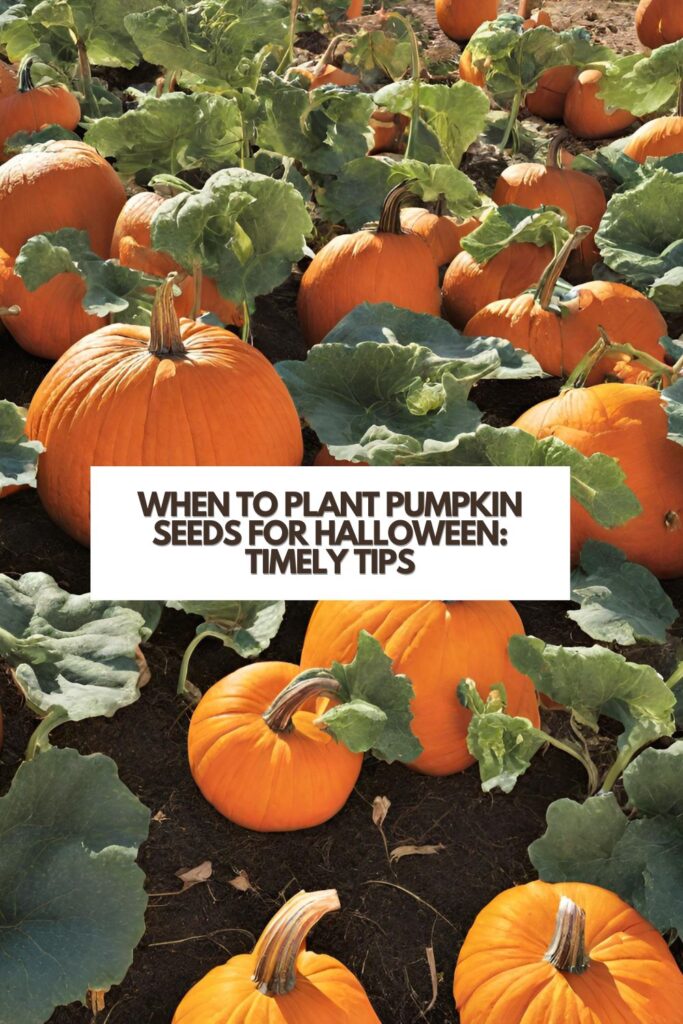As Halloween approaches, many people begin to think about how to grow their own pumpkins for jack-o’-lanterns and decorations. Pumpkins may be associated with the spooky season, but in order to have them ready in time for Halloween, you must plan ahead. Choosing just the right planting time will lead to a successful pumpkin patch and perfectly timed pumpkins to carve.
Pumpkin seeds have specific requirements when it comes to growing and nurturing them into fully grown plants. By understanding the different pumpkin varieties and their needs, you can identify the ideal planting time for your location and climate. These factors combined with proper soil preparation and planting techniques will ensure a bountiful harvest by the time October rolls around.
Key Takeaways
- Selecting the right planting time is crucial for having pumpkins ready for Halloween
- Different pumpkin varieties have unique growing requirements which affect planting times
- Proper soil preparation and planting techniques contribute to a successful pumpkin harvest
FTC DISCLOSURE: Some of the links in this post are affiliate links. If you click on them and make a purchase, I will receive a small finder’s fee on the sale. This does not increase your price in any way shape or form. Using these links help support the continuation of this website. All opinions are my own. Thank you in advance.
Understanding Pumpkin Varieties
When planning your pumpkin patch, it’s important to consider the different pumpkin varieties available. Pumpkins come in various shapes, sizes, and flavors, so choosing the right variety is crucial for achieving your desired outcome. In this section, we will discuss popular varieties for carving, gourmet varieties for eating, and giant varieties for competitions.
Popular Varieties for Carving
Carving pumpkins, also known as jack-o’-lanterns, are a staple of Halloween. When choosing a variety specifically for carving, there are a few key attributes to look for:
- Size: A good carving pumpkin should be large enough to accommodate your design.
- Shape: Round or slightly elongated pumpkins with a uniform shape are best for carving.
- Thickness: You want the pumpkin walls to be thick enough to withstand carving but not too thick that it’s difficult to work with.
Some popular carving varieties include:
- Autumn Gold: This variety is an early maturing pumpkin that is deep gold in color, making it a stunning choice for jack-o’-lanterns.
- Casper: As the name suggests, Casper pumpkins are ghostly white and provide an interesting alternative to the traditional orange pumpkin.
- Jack-O-Lantern: This classic pumpkin variety features a bright orange color and a large, round shape, making it a favorite for carving.
Gourmet Varieties for Eating
If you plan on consuming your pumpkins, there are a wide variety of gourmet pumpkin options available. These pumpkins have a finer texture and sweeter flavor than carving pumpkins and are suitable for pies, soups, and other dishes. Some popular gourmet pumpkin varieties include:
- Sugar Pie: This small, sweet pumpkin is perfect for pies, featuring a fine-grained, starchy texture and a rich, sweet flavor.
- Cinderella: With its flattened shape and vibrant red-orange color, Cinderella pumpkins are not only eye-catching but also delicious.
- Galeux d’Eysines: This unique, pinkish-gray pumpkin has a sweet, nutty flavor, making it a versatile choice for culinary enthusiasts.
Giant Varieties for Competition
For those looking to make a big splash with their pumpkins, consider growing giant pumpkins for competition. These incredible pumpkins can often weigh hundreds—or even thousands—of pounds. Here are some popular giant pumpkin varieties:
- Atlantic Giant: Known as the world record holder for heaviest pumpkin, the Atlantic Giant can weigh over 1,000 pounds and has a vibrant orange color.
- Big Max: With its smooth, bright red-orange skin, the Big Max pumpkin can weigh up to 200 pounds—an impressive size for any backyard gardener.
- Big Moon: This large pumpkin variety has a pale orange, thick, and smooth skin, with weights in the 200-pound range.
By considering the pumpkin varieties that best suit your needs, you can ensure a successful harvest and make the most of your pumpkin patch!
Identifying the Ideal Planting Time
When planting pumpkin seeds for Halloween, timing is crucial. This guide will help you determine the best planting time in both northern locations and cooler climates.
Northern Locations
In northern locations, late spring is the ideal time to plant pumpkin seeds. The planting period usually falls between late May and early June. This timing takes into account the average date of the last spring frost, which marks the start of the growing season. It’s important to wait until after the last frost to plant pumpkins, as cold weather can damage seedlings and prevent growth. You also want to make you have very rich soil.
Here is a suggested timeline for planting pumpkins in northern locations:
- Late May: Begin planting pumpkin seeds after the last frost
- June – Early July: Monitor pumpkin growth and provide necessary care
- Mid-July to Fall: Harvest pumpkins in time for Halloween
Planting Pumpkins in Cooler Locations
In cooler climates, pumpkin planting should begin in early summer. Similar to northern locations, the planting window falls around late spring to early June, but it’s crucial to wait for temperatures to consistently remain above freezing at night. This helps ensure that pumpkin seedlings aren’t exposed to frost, which could stunt their growth or kill them.
Here are some essential factors to consider when planting pumpkins in cooler climates:
- Spring Frost: Determine the average date of last frost for your region
- Soil Temperature: Make sure the soil is consistently above 60°F (15°C) before planting
- Planting Timeline: Start planting in early summer (early June) and monitor growth until fall for optimal Halloween harvest
Both northern locations and cooler climates offer the opportunity to grow pumpkins for Halloween by following these guidelines. Keep in mind that every garden is different, so adjust your planting schedule and care according to the unique needs of your pumpkin plants.
Preparing the Soil
Choosing the Best Location
When planning to plant pumpkin seeds for Halloween, picking the right location in your yard is essential. Pumpkins thrive in full sun, so select a spot that receives sunlight for most of the day. Additionally, ensure the area provides ample space for the vines to sprawl and grow.
Soil Preparation Process
To prepare the soil for pumpkin seeds, follow these steps:
- Loosen the soil: Using a garden fork or tiller, loosen the soil in the chosen area down to a depth of at least one foot. This allows pumpkin roots to penetrate the ground easily and promotes healthy growth.
- Enrich the soil: Add an adequate amount of compost, 2-3 inches, to the loosened soil to improve its nutrient content and texture. You can use homemade compost from your compost pile or purchase it from a gardening store.
- Mix the compost: Blend the compost thoroughly into the soil, ensuring an even distribution of nutrients. I add some compost from my composter. I also use this compost blend from Organic Mechanics.
- Create planting mounds: Form mounds of soil approximately 18-24 inches apart and one inch deep. These elevated structures contribute to proper drainage and provide an ideal planting environment for pumpkin seeds.
By selecting an ideal location and properly preparing the soil, you can maximize the chances of growing healthy, vibrant pumpkins in time for Halloween. Implementing these techniques can lead to an impressive pumpkin harvest and make for unforgettable Halloween festivities.
Planting the Pumpkin Seeds
Seed Selection and Germination
To ensure a healthy and bountiful harvest, it’s essential to start with high-quality pumpkin seeds. Please also understand when your last frost date is and whether you have a long growing season. Choose seeds from a reputable supplier and opt for varieties that are known to thrive in your region. To improve the success rate, you can germinate the seeds indoors before planting them outside.
To germinate pumpkin seeds, follow these steps:
- Soak the seeds in water for 12-24 hours.
- Place the seeds on a damp paper towel.
- Fold the paper towel over the seeds and place them in a sealed plastic bag.
- Store the bag in a warm area, ideally between 70-85°F (21-29°C).
- Check on the seeds daily for signs of growth and keep the paper towel moist.
The seeds should germinate within 5-10 days. Once the seedlings have a set of true leaves, they are ready for transplanting outdoors.
Planting and Spacing Method
When it comes to planting pumpkin seeds, timing is crucial for a successful Halloween harvest. Plant the seeds outdoors in late spring or early summer, when soil temperatures reach at least 60°F (15°C) and all danger of frost have passed.
To plant pumpkin seeds, follow these steps:
- Choose a well-draining area of your garden that receives full sun for at least six hours a day.
- Prepare the soil by loosening it and mixing in organic compost for added nutrients.
- Create small hills, approximately 4-6 feet (1.2-1.8 meters) apart, to promote better drainage and give the pumpkin vines enough space to spread out.
- Plant 3-4 germinated seeds per hill, spacing them about 1 inch (2.5 cm) apart.
- Cover the seeds with 1 inch (2.5 cm) of soil and water the area thoroughly.
Monitor the seedlings’ growth and, once they reach 2-3 inches (5-7.5 cm) in height, thin them out by removing weaker seedlings and leaving the strongest plant in each hill. Proper spacing will help prevent the plants from competing for nutrients and reduce the risk of disease. Remember to water the pumpkin plants consistently, providing 1 to 2 inches (2.5 to 5 cm) of water per week depending on the weather conditions and soil type.
Caring for Pumpkin Plants
Watering the Plants
Proper watering is essential for healthy pumpkin plants. They need consistent moisture to grow and thrive. It’s best to water them early in the morning, as this allows the plants to fully absorb the moisture throughout the day. To avoid excessive evaporation, apply water directly to the soil near the base of the plant, rather than sprinkling it on the leaves. It is recommended to give your pumpkin plants 1 to 2 inches of water per week, depending on the weather conditions. For optimal growth, ensure the soil remains moist but not waterlogged.
Pruning Techniques
Pruning is an important aspect of growing pumpkins for Halloween. As the plants mature, it is necessary to remove some of the vines and foliage to promote better air circulation and to focus the plant’s energy on developing healthy, larger pumpkins. Use clean, sharp pruning shears and wear gloves for protection. Trim any dead or diseased leaves, as well as excess lateral vines that do not host a pumpkin, ensuring you leave at least 1-2 inches of the vine attached. By regularly monitoring and pruning your pumpkin plants, you will set them on the right path for a successful harvest.
Managing Pests and Diseases
Recognizing Common Pests
Pumpkin plants are susceptible to various insects and pests that can hinder their growth and affect the final yield. One of the most common pests encountered in pumpkin patches are squash bugs, which can damage leaves and cause wilting.
Additionally, aphids and cucumber beetles are also known to infest pumpkin plants.
While beneficial insects like bees play a crucial role in pollination, it’s essential to identify and manage the harmful pests in your pumpkin patch. Regularly inspect the plants and keep an eye out for any signs of infestations to ensure timely action.
Be sure to give them plenty of space to avoid the development of powdery mildew on your plant and leaves.
Treatment Options
To effectively manage pests and diseases in your pumpkin patch, consider using a combination of natural and chemical treatment options. Here are some suggestions:
- Natural methods: Introduce beneficial insects like ladybugs and lacewings, which feed on harmful pests like aphids. Additionally, practice crop rotation and companion planting to reduce the chances of infestations.
- Cultural practices: Maintain a clean pumpkin patch by removing any plant debris or fallen fruits that might attract pests. Regularly monitor plants and handpick insects like squash bugs as soon as you spot them.
- Chemical options: Apply insecticides or pesticides carefully, following the manufacturer’s instructions. Make sure to target only the harmful pests and avoid harming the beneficial insects.
It’s essential to choose the most suitable treatment option based on the severity of the infestation and the specific pests found in your pumpkin patch. Keeping a vigilant eye and taking timely actions will ensure a healthy and bountiful pumpkin harvest for your Halloween season.
Tracking the Growth and Maturity
Identifying Healthy Growth
During the growth period, it is essential to monitor the pumpkin plants to ensure they develop properly. Healthy pumpkin growth can be identified by sturdy stems and vibrant green leaves. As the pumpkin fruits develop, their size and color will change. Regularly checking on the growth helps to detect any potential issues early on.
Some indicators of healthy pumpkin growth include:
- Thick and strong stems
- Large, green leaves
- Gradual increase in the size of the pumpkin fruits
Recognizing a Ripe Pumpkin
Once the pumpkin plants have reached maturity, it is time to harvest them for Halloween. To determine if a pumpkin is ripe and ready for harvest, observe its color and the hardness of its rind. A ripe pumpkin typically has a deep, consistent orange color and a hard rind. Mature pumpkins also have a firm stem that is beginning to dry out and may have a slightly wrinkled appearance.
Here are some signs that a pumpkin is ripe:
- Deep orange color
- Hard rind
- Firm and dry stem
By consistently keeping track of the growth and maturity of your pumpkin plants, you can ensure a healthy harvest in time for Halloween. Remember to pay attention to the stem, color, and rind of the pumpkin fruits to identify mature pumpkins and enjoy the process of growing your own festive decorations.
Harvesting and Storing Pumpkins
Harvest Timing
When planting pumpkins for Halloween, it is important to consider the timing of harvest. Planting pumpkin seeds should be done in late May or early June, allowing approximately 90 to 120 days for the pumpkins to fully mature. This ensures pumpkins will be ready to harvest by October. If you plan to use the harvested pumpkins for Thanksgiving, planting can be done slightly later.
Proper Harvesting Techniques
Proper harvesting techniques are essential to ensure the longevity of your pumpkins. Wait until the pumpkin has reached its optimal color and the vines have dried and begun to wither. When harvesting, be sure to use a sharp, clean knife or pruning shears. Make a clean cut, leaving a few inches of stem attached to the pumpkin. Avoid carrying pumpkins by their stems, as this can cause them to break and lead to premature rotting.
Optimal Storage Conditions
Once harvested, it is crucial to properly store your pumpkins for extended shelf life. Pumpkins should be cured for about 10 days in a warm, dry area with a temperature of 80-85°F. After curing, store pumpkins in a cool, dry place with a temperature of 50-55°F. Keep pumpkins elevated on racks to allow proper air circulation and prevent rotting. Check pumpkins regularly for any signs of decay and promptly remove any affected specimens.
Frequently Asked Questions
When it comes to planting pumpkin seeds for Halloween, many people have questions about the best time and methods. This section aims to address some of the most frequently asked questions in a clear, knowledgeable, and concise manner.
One of the most common questions is, when should pumpkin seeds be planted? The ideal time to plant pumpkin seeds varies by region and specific weather conditions, but in general, it’s best to plant seeds between late May and early July. This timeframe allows for pumpkin plants to mature and produce fully-grown, ripe pumpkins by October.
Another question people often ask is, what is the proper spacing and depth for planting pumpkin seeds? To achieve the best growth, plant seeds in rows and place them about 2 inches deep and 4 to 6 feet apart. This distance ensures that the plants have sufficient space to grow and prevents overcrowding, which may lead to smaller and underdeveloped pumpkins.
How can I ensure that my pumpkin plants get enough water and nutrients? Proper watering and fertilization are crucial for growing healthy pumpkins. It’s essential to water the plants regularly, providing at least 1 inch of water per week, especially during the fruiting period. Additionally, applying a balanced fertilizer every few weeks can support healthy growth and encourage a bountiful harvest.
Lastly, people often wonder, how long does it take for pumpkin seeds to germinate? Pumpkin seeds typically take between 7 to 10 days to germinate when the soil is warm, at least 70°F. Patience is key, as germination may take longer if the soil’s temperature is cooler.
Also germination time depends slightly on the types of pumpkins that you are planting in your own pumpkin patch. Smaller varieties my come to harvest much sooner than larger pumpkins.
By addressing these frequently asked questions, this section seeks to provide a reliable and concise resource for individuals looking to grow pumpkins from seeds for Halloween.
Conclusion
Planting pumpkin seeds at the right time is essential for having perfectly ripe and ready pumpkins for Halloween. Generally, it is best to plant pumpkin seeds between late May and early July. This allows enough time for the pumpkins to mature before the holiday.
Several factors must be considered when deciding on the exact planting time. These include:
- Climate: Pumpkin plants require warm soil and temperatures to germinate and grow successfully. Ensure the last frost has passed before planting seeds.
- Pumpkin Variety: Each pumpkin variety has a different maturity period. Choose a variety that suits your region’s climate and has a maturity period that aligns with Halloween.
- Growing Space: Make sure there is adequate space for the plants to grow, as they require proper air circulation and room for their vines to expand.
To increase the chances of successful pumpkin growth, consider:
- Using raised beds or high-quality garden soil to provide ample drainage.
- Applying organic compost and a balanced fertilizer to boost plant growth.
- Planting seeds about an inch deep and giving them enough room to grow (at least 5 feet apart).
By considering these factors and following proper planting techniques, one can successfully grow pumpkins that are ready in time for Halloween. Remember that proper care, such as watering and pest prevention, is crucial throughout the growing season for robust and healthy pumpkins. With a little planning and effort, you can have a delightful pumpkin harvest to enjoy this Halloween.














